Sweetness and Lightning 03
Amaama to Inazuma episode 03
SPOILER Summary/Synopsis:
 Kotori gets up to find her mother gone, but her mother has prepared a large breakfast for Kotori. She also leaves a note for Kotori, telling her she’ll be on live TV at 7:15. Kotori turns on the TV on her phone and is horrified to see her mother in a sailor outfit. At school, she complains to Kouhei-sensei about this. She then discusses Kouhei’s not so great attempt at making breakfast for Tsumugi. Elsewhere, Tsumugi is attempting to make hamburg steak out of clay for her father. The other girls in the class give her their clay, causing the boy Mikio to become jealous and raise a stink. Kouhei is called to the kindergarten because of this.
Kotori gets up to find her mother gone, but her mother has prepared a large breakfast for Kotori. She also leaves a note for Kotori, telling her she’ll be on live TV at 7:15. Kotori turns on the TV on her phone and is horrified to see her mother in a sailor outfit. At school, she complains to Kouhei-sensei about this. She then discusses Kouhei’s not so great attempt at making breakfast for Tsumugi. Elsewhere, Tsumugi is attempting to make hamburg steak out of clay for her father. The other girls in the class give her their clay, causing the boy Mikio to become jealous and raise a stink. Kouhei is called to the kindergarten because of this.
 Tsumugi won’t be consoled, even when Mikio’s mother gets the boy to apologize. Kouhei takes Tsumugi home, where he tells his depressed daughter he knows she’s not a thief. The next day, he takes Tsumugi to Kotori’s restaurant so they can make hamburg steak, but Tsumugi is still depressed. Kotori encourages Kouhei to listen to Tsumugi, so he goes to her. Tsumugi is still depressed at being thought of as a thief. Kouhei manages to cheer her and tells her he loves her. Tsumugi helps make the meal, but as they start to eat, she starts crying again. After being hugged by her dad, Tsumugi is cheered again and eats. When Kotori asks, Tsumugi says she was making a present for her dad’s birthday, which is today. This horrifies Kotori, who offers some of her food to Kouhei as a present.
Tsumugi won’t be consoled, even when Mikio’s mother gets the boy to apologize. Kouhei takes Tsumugi home, where he tells his depressed daughter he knows she’s not a thief. The next day, he takes Tsumugi to Kotori’s restaurant so they can make hamburg steak, but Tsumugi is still depressed. Kotori encourages Kouhei to listen to Tsumugi, so he goes to her. Tsumugi is still depressed at being thought of as a thief. Kouhei manages to cheer her and tells her he loves her. Tsumugi helps make the meal, but as they start to eat, she starts crying again. After being hugged by her dad, Tsumugi is cheered again and eats. When Kotori asks, Tsumugi says she was making a present for her dad’s birthday, which is today. This horrifies Kotori, who offers some of her food to Kouhei as a present.
Thoughts/Review:
OK, this series is awesomeness and a half. Maybe it shouldn’t be, but it is somehow.
The three episodes have been pretty much the same deal. Something happens with Tsumugi and Kouhei, then they end up preparing and eating a meal with Kotori. On the surface, this really sounds boring, so credit to the writing for making it so good. “Hanyaan!”
We finally get to see Kotori’s mother. I laughed out loud because I didn’t expect what I saw. Kotori’s mother has to be in her thirties, but she’s wearing a sailor seifuku.
So yeah, if my mom had done something like that, this would be my expression as well. 😆
On the not funny side, a depressed Tsumugi tore me up something fierce. She’s always so positive and cheerful. So when that little bastard Mikio decided to be a punk on Tsumugi, I’m thinking, “someone needs a paddlin‘!”
I like how Tsumugi’s depression affected Kotori so that she’s able to give Kouhei some advice. I don’t know how long she’s been alone and in need of someone to be there for her, but she clearly understood what Tsumugi needed. That lead to a sweet moment between father and daughter.
At the same time, it also made me start to want Kotori and Kouhei to eventually become a couple. Not only do they work together well in the kitchen, but Kotori seems like she’d be a good mom.
And speaking of Kotori’s and Kouhei’s relationship, it amuses me to see how they have personal talks at school. Actually, it does more than amuse me. By having Kotori outside the window in a place no one goes with Kouhei casually standing there looking the other way, they avoid any rumors. Further, I like how it represents that just being in each other’s company is good for both of them.
You know, this really doesn’t feel much like a seinen series, does it? Seinen titles are allowed to be more adult, but this one isn’t risque at all, which makes me happy. In that regard, I guess it is somewhat like Yotsuba&. In some ways, this feels like a shoujo or josei cooking manga with a hint of romance, mixed with some slice of life. I’m OK with that.
Finally, there’s the food. I swear, after every episode that I watch, I feel hungry as can be. 😆
In the end, Sweetness and Lightning 03 is another really enjoyable romp into a world that I like being in.



 July 19th, 2016
July 19th, 2016  AstroNerdBoy
AstroNerdBoy 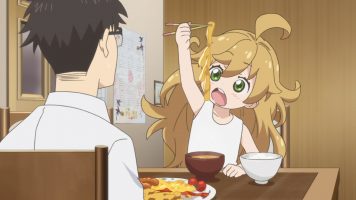
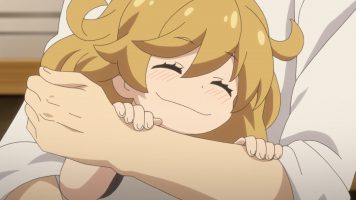
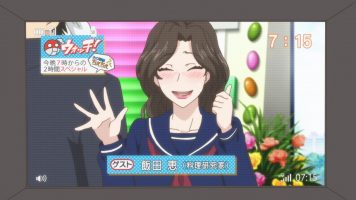





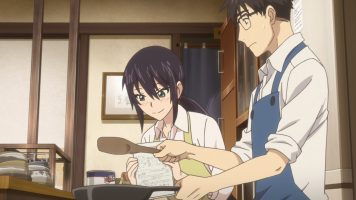
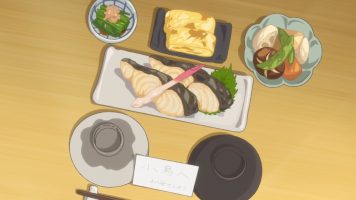
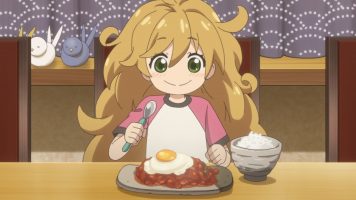
 Posted in
Posted in  Tags:
Tags: 
A review of “When Marnie was There”
Twelve year ofd Anna’s resentment of her mother, whom she calls “Auntie,” comes from knowing that she is a foster child and her mother secretly gets a government stipend for her support. Anna feels that horrible isolation of being what she thinks is different from the lucky people inside “the circle.” And Anna hates herself. She thinks herself “ugly, stupid, moody and unpleasant.” But she draws pencil extrememly well! Greatly worried, her mother sends her to a benign country couple, the Oiwas, who live on a broad, shallow tidal basin called ‘the marsh in coastal Hokkaido on order to help cure Anna’s Stress induced asthma.
The director, Hiromasa Yonebayshi, escorts us into this setting, whose quality is equal to that of his “Arrietty,” whose backgrounds are the best in all of anime. It’s different, of course, because the lighting is of necessity slightly darker and subdued, but its just as good. The cloudy skies and grey water of tjhe marsh are featured, but when the sun is out the setting is gorgeous! Natural details appear everywhere.
Gently, subtly we are taken along with Anna as she begins to explore the canonical old, abandoned mansion, called Marsh House, across the basin. There she meets a beautiful girl with long blonde hair (and Yonebayashi-sensie gets her exactly right) named Marnie. Anna has dark brown and gently curle, short hair. Interestingly, they both have big beautiful blue eyes. For Anna they are a shameful anomaly. Anna falls in love Marnie on their explorations together. Marnie tells Anna that she has loved her for along time. In and out of Anna's dream they meet often, giving the viewer, and Anna, no warning when Marnie disappears. Of course, Marnie is a spirit, but she is so ral, and the revived mansion so real that this viewer had no trouble suspending disbelief because their time together is so wonderful. The director gives us what will become an iconis scene when Marnie teaches Anna how to dance on an outside courtyard of the mansion during one of Marnie’s mother’s elaborate parties. The only music they have is Marnie’s gentle humming as they circle together.
At the end of summer, when Anna’s mother comes to pick her up, Anna has lost her melancholy and self-hatred. She i s happy. From various pieses of evidence Anna finally learns who Marnie was. An ancient photograph gives Anna the final piece of the puzzle.
I very strongly recommend this movie, but make sure you have a box of tissues with you
I know youall are dying to know who Marnie is. She’s Anna’s grandmother. She has a very sad back story as a neglected and abused rich girl who resides at Marsh house when her mother is absent, which is most of the time. The wicked housekeeper, Nan, attacks her by grabbing her and dragging her places and brushing her beautiful hair so hard it makes Marnie cry. Also, the twin maids bully and threaten her routinely.
But for one wonderful summer she has Anna as a friend. There she can be smiling, happy and adventurous. Later, when Marnie and two-year-old Anna are the only survivors of their family, she has custody of Anna and stays with her while she showers her with love. She gives Anna a blue hair clip, which Anna wears during the second half of the story. Then Marnie dies, leaving Anna in custody of the state, hence Anna’s feelings of estrangement when she is twelve. She is adopted by “Auntie” and the story becomes Anna’s revisiting that past time with Marnie at Marsh House for that wonderful summer. Marnie has rescued Anna through time and powerful love. At the end with a happy Anna introducing “Auntie” to one of Marnie’s childhood friends, she introduces her as “mother.”
I should make you a guest blogger. 😉
I’m continually thankful for your patience. Being able to bring my ideas into public is very gratifying. If only one or two people read this, I’m happy.
I looked at “Arrietty” again along with Shinkai’s “5cm per Second” and “The Garden of words” to see if my dictum that “Arrietty” has the best backgrounds can stand valid. Very tough call. They’re both so good, I’ve decided not to decide. Flip a coin.
What Yonebayashi-sensei does better than anybody is interiors. I’d love to visit Marsh House when Marnie was there.
The interior of Shawn’s mother’s house in “Arrietty,” which becomes the background for most of the movie exemplifies my thesis. Upper class from the teens and twenties, wainscoating, filigreed wallpaper, wood stairs, etc.the house feels like home to me. When Arrietty and her father do mountaineering to get to the sugar, I was right there with them. Great stuff. Incidentally, Hara, the resident housekeeper is a terrific villain. She’s got what I call malignant virtue, which makes for some really nasty characters. Carol Burnett voices her in the English version!
I hope twelve year old girls everywhere can see “When Marnie Was There.”